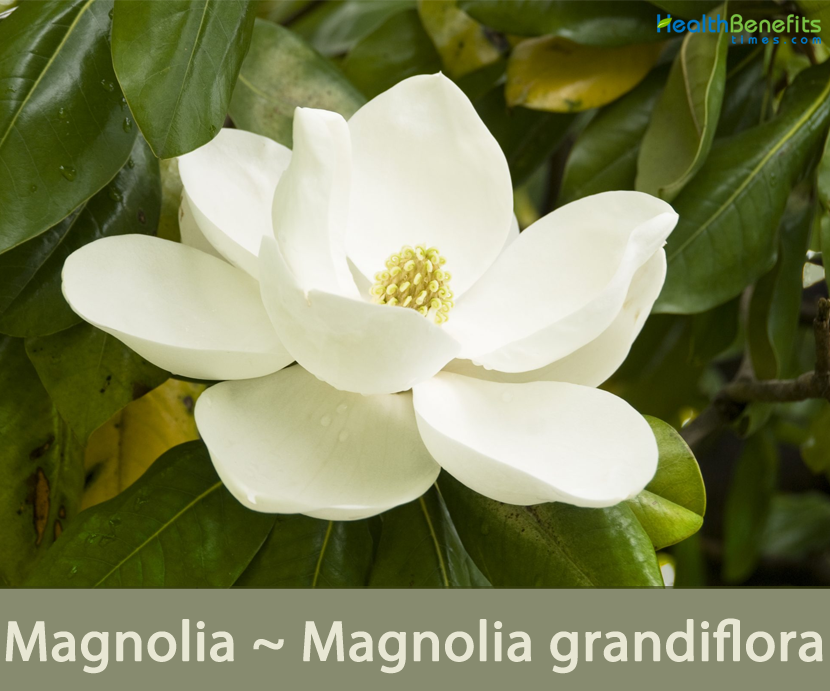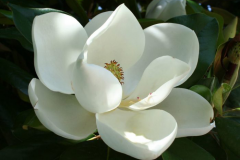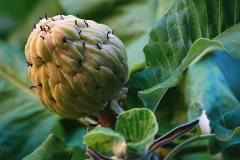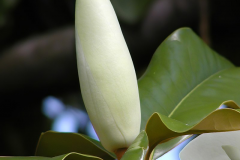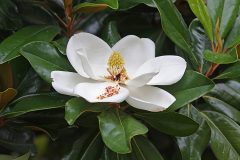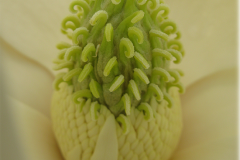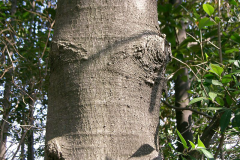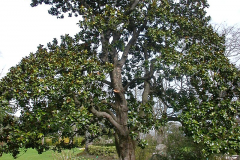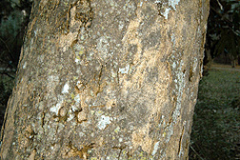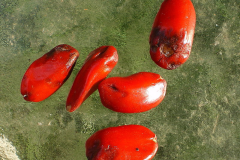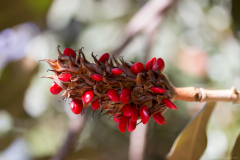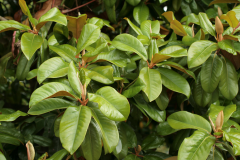Genus name honors Pierre Magnol, French botanist (1638-1715). Specific epithet is from Latin meaning large flowers. The plant has large fragrant white flowers and evergreen leaves that make it one of the most splendid of forest trees and a very popular ornamental that has been planted around the world. Magnolia has long been praised in Chinese traditional medicine but it is now widely regarded as a beneficial supplement or herbal remedy around the world. The plant grows with other hardwoods and is marketed as magnolia lumber along with other magnolia species to make furniture, pallets, and veneer. Wildlife eats the seeds, and florists prize the leathery foliage. The timber is hard and heavy, and has been used commercially to make furniture, pallets, and veneer.
Magnolia Facts
| Magnolia Quick Facts | |
|---|---|
| Name: | Magnolia |
| Scientific Name: | Magnolia grandiflora |
| Origin | Extends from North Carolina along the Atlantic Coast to central Florida, westward through the southern half of Georgia, Alabama, and Mississippi, and across Louisiana into eastern Texas |
| Colors | Initially green turning to red or red brown with age |
| Shapes | Dry, cylindrical, hairy, 3–5 in long (8–13 cm) carpels containing bright red, glossy, ovoid seeds 1.4 × 0.6 cm |
| Taste | Bitter |
| Health benefits | Overcome Chest disruption, Cure Cough, Treat Sinusitis, Treat Flatulence, Treat Vertigo Disorders, Eliminate Body Odor, Helps Treat Insomnia, Diabetes Treatment, Reduces Gingivitis, Menstrual Cramps, Anti-allergenic, Improves Liver Health, Alzheimer’s disease, Respiratory Issues, Promotes Weight Loss, Anxiety Treatment, Lower Blood Pressure, Anticancer Potential |
| Name | Magnolia |
|---|---|
| Scientific Name | Magnolia grandiflora |
| Native | Extends from North Carolina along the Atlantic Coast to central Florida, westward through the southern half of Georgia, Alabama, and Mississippi, and across Louisiana into eastern Texas |
| Common Names | Big Laurel, Bull Bay, Great Laurel Magnolia, Large-Flower Magnolia, Laurel-Leaved Magnolia, Southern Magnolia, Evergreen Magnolia, Loblolly Magnolia |
| Name in Other Languages | Afrikaans: Magnolia Albanian: Manjolia, manjole Amharic: Maginolīya (ማግኖሊያ) Arabic: Shajaratan almaghnulia (شجرة المغنولية), maghnwlya kabirat al’azhar (ماغنوليا كبيرة الأزهار) Armenian: magnolia (մագնոլիա), khoshoratsaghik magnolia (խոշորածաղիկ մագնոլիա) Assamese: Dulee-champa Azerbaijani: Maqnoliya, İriçiçək maqnoliya Basque: Magnolia, magnòlia lorandi Belarusian: Mahnoliya (магнолія), Mahnoliya buynakvetkavaya (Магнолія буйнакветкавая) Bengali: Ēkaprakāra phulēra gācha (একপ্রকার ফুলের গাছ), udaẏapadma (উদয়পদ্ম) Bosnian: Magnolija Bulgarian: Magnoliya (магнолия), vechnozelena magnoliya (вечнозелена магнолия), edrotsvetna magnoliya (едроцветна магнолия ) Burmese: T tine mwhaayy (တတိုင်းမွှေး) Catalan: Magnòlia Cebuano: Magnolia Chichewa: Magnolia Chinese: Guang Yulan, He hua mu lan, Hou po, Yang yulan, yùlán (玉兰, mùlán shǔ (木兰属), Héhuā yùlán (荷花玉兰) Corsican: Magnolia Croatian: Magnolija, Velecvjetna magnolija Czech : Šácholan velkokvětý, magnólie Danish : Storblomstret Magnolie, magnolia Dotyali: Rookh kamal (रूख कमल) Dutch: Zuidelijke magnolia, magnolia English: Bull bay, Laurier tulipier, Southern magnolia, Big-laurel, Evergreen Magnolia, Giant flowered magnolia, Large-flowered Magnolia, Evergreen Magnolia, Laurel Tree of Carolina, Magnolia altissima flore ingenti candido Esperanto: Magnolia Estonian : Suureõieline magnolia, magnolia Filipino: Magnoliya Finnish : Kuningasmagnolia, magnolia French: Laurier Tulipier, Magnolia à grandes fleurs, Magnolia toujours vert, magnolia, magnolia d’Amérique, magnolia toujours vert Frisian: Magnolia Galician: Magnolia, Magnolio común Georgian: magnolia (მაგნოლია),didq’vavila magnolia (დიდყვავილა მაგნოლია) German: Großblütige Magnolie, Immergrüne Magnolie, Magnolie Riesenlorbeer Greek: Magnolia (μαγνολία) Gujarati: Mēgnōliyā (મેગ્નોલિયા) Haitian Creole: Magnolia Hausa: Magnolia Hawaiian: Magnolia Hebrew: מגנוליה, מגנוליה גדולת פרחים Hindi: Him Champa (हिम चम्पा), maiganoliya (मैगनोलिया) Hmong: Magnolia Hungarian: Örökzöld liliomfa, magnólia növény, nagyvirágú liliomfa Icelandic: Magnolia Igbo: Magnolia India : Andachampa, Him champa, Oothambal Indonesian: Magnolia Irish: Magnolia Italian: Magnolia, magnolia a grandi fiori, magnolia americana Japanese: Magunoria (マグノリア), Taisanboku (タイサンボク) Javanese: Magnolia Kannada: Magnōliya (ಮಾಗ್ನೊಲಿಯ), Dodda-billi-sampige Kazakh: Magnoliya (магнолия) Khmer: Magnolia Kinyarwanda: Magnolia Korean: Moglyeon (목련), tae san mog (태산목) Kurdish (Kurmanji): Magnolia Kyrgyz: Magnoliya (магнолия) Lao: Magnolia Latin: Magnolia grandiflora Latvian: Magnolija Lithuanian: Magnolija Luxembourgish: Magnolia Macedonian: Magnolija (магнолија), krupnocvetna magnolija (крупноцветна магнолија) Malagasy: Magnolia Malayalam: Magnolia, krupnocvetna magnolija (മഗ്നോലിയ ഗ്രാൻഡിഫ്ളോറ) Malay: Magnolia Maltese: Magnolia Mandingo: Oottambal Manipuri: Oothambala (ঊথম্বাল) Maori: Magnolia Marathi: Kavati-chafo, Mĕgnōliyā (मॅग्नोलिया) Mongolian: Zambaga (замбага) Myanmar (Burmese): Magnolia Nepali: Maiganoliya (मैगनोलिया), Rukh Kamal (रुख कमल) Norwegian: Magnolia Odia: ମାଗ୍ନୋଲିଆ | Pashto: مګنولیا Persian: ماگنولیا, مگنولیای جنوبی Polish : Magnolia wielkokwiatowa, magnolia Portuguese: Magnólia, Magnólia-Branca, Magnóliade- flores-grandes, Magnólia-sempre-verde, magnolia Punjabi: Maiganōlī’ā (ਮੈਗਨੋਲੀਆ) Romanian: Magnolie Russian: Magnoliya (магнолия), magnoliya krupnotsvetkovaya (магнолия крупноцветковая) Samoan: Magnolia Scots Gaelic: Magnolia Serbian: Magnolija (магнолија) Sesotho: Magnolia Shona: Magnolia Sindhi: مگنوليا Sinhala: Magnolia Slovak: Magnolia Slovenian: Magnolija Slovašcina : Magnolija velecvetna Slovene: Velecvetna magnolija Somali: Magnolia Spanish : Laurel Tulipan, Lauro-Tulipan, Magnòlia, magnolia de Los Jardines, Magnolia lorandi, Magnolier, Magnoliera, Magnolio, magnolia común, magnolio común, capire, capiri, cosahuico, cozahuico, huacux, hucux, kps luluw, tempisque, tempixque Sundanese: Magnolia Swahili: Magnolia Swedish: Kungsmagnolia, magnolia Tajik: Magnolia (Магнолиа) Tamil: Mākṉōliyā (மாக்னோலியா), Makṉōliyā kirāṇṭiḥpuḷōrā (மக்னோலியா கிராண்டிஃபுளோரா) Tatar: Magnoliya (магнолия) Telugu: Māgnōliyā (మాగ్నోలియా) Thai: Mæk no leīy (แมกโนเลีย) Turkish: Büyük çiçekli manolya, manolya Turkmen: Magnoliýa Udmurt: Badz̈ym syas’kaë magnoliya (Бадӟым сяськаё магнолия) Ukrainian: Mahnoliya (магнолія), mahnoliya velykokvitkova (магнолія великоквіткова) Upper Sorbian: Wulkokwětkaty lilijowc Urdu: میگنولیا Uyghur: magnolia Uzbek: Magnolia Vietnamese : Hoa Mộc Lan, Mộc lan Welsh: Magnolia Xhosa: Magnolia Yiddish: Magnoulia (מאַגנאָוליאַ) Yoruba: Magnolia Zulu: Magnolia |
| Plant Growth Habit | Medium to large, fast growing, evergreen, typically straight and erect tree |
| Growing Climates | Growing on the margins of ponds and swamps, ravines, hummocks, wooded floodplains, sand dunes, wooded dunes, buffs and sandy bottoms, lowland areas, river bottoms, mesic woods, woodlands, maritime forests and bottomlands |
| Soil | Rich fertile, moist, well-drained soil in its native range. It does not tolerate inundation and frost |
| Plant Size | 60 to 90 feet (18-27 m) tall |
| Root | Rope-like, and unbranched. The roots can extend up to four times the canopy width |
| Bark | Brown to gray, thin, smooth/lenticellate when young, later with close plates or scales. |
| Twigs | Stout, with white to rusty tomentum and a long (1 to 1 1/2 inches) silky white to rusty red terminal bud |
| Leaf | Simple, alternate, broadly ovate about 13–20 cm (5–8 in) long and 5-8 cm (2–3 in) broad, with smooth entire margins. They are very thick and leathery, without teeth, and have a dark green, stiff, smooth, shiny surface above and a fuzzy, rusty color below |
| Flowering season | June to September |
| Flower | Flowers are large, 6–8 in (15–20 cm) wide fragrant, showy, white, lemon citronella-scented, monoecious flowers (having male and female reproductive organs on same plant) on stout, hairy stalks. The flowers may have 6–15 petals with a waxy texture, emerging from the tips of twigs on mature trees in late spring. |
| Fruit Shape & Size | Aggregate of dry, cylindrical, hairy, 3–5 in long (8–13 cm) carpels containing bright red, glossy, ovoid seeds 1.4 × 0.6 cm |
| Fruit Color | Initially green turning to red or red brown with age |
| Seed | Seeds are ½ in (1.3 cm) long kidney shaped that can be red, orange or pink in color |
| Propagation | By fresh, cold-stratified seeds or semi-hardwood cuttings |
| Flavor/Aroma | Strong and pleasing fragrance |
| Taste | Bitter |
| Plant Parts Used | Flowers, leaves |
| Lifespan | 80–120 years |
| Season | September to November |
| Available Form | Pills, powders, tinctures or teas |
| Health Benefits |
|
| Culinary Uses |
|
Plant Description
Magnolia is a medium to large, fast growing, and evergreen, typically straight and erect tree with spreading branches that form a dense, broadly pyramidal crown. The tree normally grows about 60 to 90 feet (18-27 m) tall. The trunk attains a diameter of 1.8 m. The tree has brown or grey bark that is smooth when the plant is young. As the plant gets older it has a grey-brown, thinly scaly and fissured bark. Twigs, vegetative buds and petioles are densely brown to greyish brown and shortly tomentose. The stems have vertical lenticels and shield-shaped leaf scars. The pith is large, white, and blocky in appearance. The tree may live 80– 120 years.
The plant is found growing on the margins of ponds and swamps, ravines, hummocks, wooded floodplains, sand dunes, wooded dunes, buffs and sandy bottoms, lowland areas, river bottoms, mesic woods, woodlands, maritime forests and bottomlands. The plant prefers rich fertile, moist, well-drained soil in its native range. It does not tolerate flood and frost. The flowers and bark of magnolia plants have been admired for their multiple medicinal applications. Some of the healing properties are based in traditional medicine, while others have been revealed through modern research into the exact chemical components of the flower, its extracts, and the composition of the bark.
Leaves
The leaves are simple, alternate, broadly ovate about 13–20 cm (5–8 in) long and 5-8 cm (2–3 in) broad, with smooth entire margins. They are very thick and leathery, without teeth, and have a dark green, stiff, smooth, shiny surface above and a fuzzy, rusty color below. The leaves have pinnate venation and the margins of the leaves are smooth. The leaves can persist on the tree for approximately two years. In the spring, they have a golden to rust color on their undersides.
| Leaf arrangement | Alternate |
| Leaf type | Simple |
| Leaf margin | Entire |
| Leaf shape | Elliptic (oval), ovate |
| Leaf venation | Brachidodrome, pinnate |
| Leaf type and persistence | Evergreen, broadleaf evergreen |
| Leaf blade length | 4 to 8 inches |
| Leaf color | Dark green and glabrous on top, paler green and covered with a dense, rusty pubescence underneath |
| Fall color | No color change |
| Fall characteristic | Not showy |
Flowers
The terminal flower bud ¾–1 ¼ in (2–3 cm) long, is brown and pubescent, and tapers at the apex. The lateral/axillary bud is small (¼ in) and is slightly shrouded in hair. The tree flowers from late spring to fall; producing large, 6–8 in (15–20 cm) wide fragrant, showy, white, lemon citronella-scented, monoecious flowers (having male and female reproductive organs on same plant) on stout, hairy stalks. The flowers may have 6–15 petals with a waxy texture, emerging from the tips of twigs on mature trees in late spring. Color of the flower depends on the species and it can be white, yellow, pinkish, purple and green. Magnolia blooms from April to June. First flowers develop seven years after planting.
| Flower color | Creamy white |
| Flower characteristics | Very showy; very fragrant; saucer-shaped |
| Flowering | Spring and summer |
Fruit
Fertile flower are followed by an aggregate of dry, cylindrical, hairy, 3–5 in long (8–13 cm) carpels that turn red/red brown with age. Each follicle consists of one ½ in (1.3 cm) long kidney shaped seed that can be red, orange or pink in color. The slightly flattened seed remains attached to the open pod by a thin, elastic thread at maturity. Seed of magnolia is favorite food of many birds.
In the US, the magnolia is used as a street tree, a free standing specimen, a framing tree, or shade tree. In most parts of India, magnolias are grown only in select well-maintained gardens. In Manipur, magnolias are commonly grown – the Manipuri name ootahmbal means “tree lotus” – flowers are used as offering in puja.
| Fruit shape | Elongated |
| Fruit length | 3 to 5 inches |
| Fruit covering | Dry or hard |
| Fruit color | Green to bright red with maturity |
| Fruit characteristics | Attracts birds; showy; fruit/leaves a litter problem |
| Fruiting | Fall |
History and Origin of Magnolia
Magnolias come from the Southern part of the United States (Georgia), China, East Asia, and parts of North America. The Magnolia is commonly seen in front gardens and is valued for its amenity value. While there is no doubt that the genus produces some gorgeous specimens, its complex history is equally admirable.
Here are some historical facts about Magnolia flowers and their origin.
According to fossil records, the Magnolia genus has existed since the Cretaceous epoch that is around 145-66 million years ago, making it the first blooming plant. Prior to this period, only conifers and cycads graced the land, which was followed by ferns and horsetails.
The term Magnolia originally appears in 1703 in Charles Plumier’s (1646–1704) Genera for a blooming tree from Martinique (talauma). After Plumier, English botanist William Sherard, who studied botany in Paris under Magnol’s pupil Joseph Pitton de Tournefort, was most likely the first to use the genus name, Magnolia.
Botanists and plant hunters traveling Asia around the end of the 18th century began naming and describing Magnolia species native to China and Japan.
Carl Peter Thunberg collected and described Magnolia obovata from Japan shortly after, in 1794, and Magnolia kobus was also gathered at around the same period.
Health Benefits of Magnolia
Traditional Chinese medicine has long recognized the benefits of magnolia. Magnolia bark has been used for centuries to manage depression, low blood pressure, promote brain health, and even reduce menopause symptoms. Researchers have linked these health benefits to its high bioactive compounds content. Let us look at the most important health benefits of the magnolia flower and bark.
1. Anticancer Potential
According to a research conducted by Lin S. et al, magnolol, a compound found in Magnolia, might prove useful in restricting the proliferation of cancer cells. Another compound honokiol, is also looked at as an anticancer agent. Research published in the Current Molecular Medicine journal has encouraged clinical trials to explore the potential of this compound as a natural, novel anticancer agent. (1), (2)
2. Lower Blood Pressure
Honokiol, one compound in the magnolia bark, was found to relax the aortas and lower blood pressure. Though we need more research on this, this sure is a step in the right direction. (3)
3. Anxiety Treatment
Honokiol has certain anxiolytic qualities that directly impact the hormonal balance in the body, particularly in terms of stress hormones. By regulating the endocrine system, magnolia might help reduce anxiety and stress by soothing the mind and lowering hormone release in the body. A similar chemical pathway allows it to help relieve depression as well, by stimulating the release of dopamine and pleasure hormones that can help turn 5. your mood around. (4)
4. Promotes Weight Loss
Magnolia bark can actually increase weight by stimulating food cravings due to its corticosteroid nature, magnolia supplements may help suppress appetite, which can help anyone trying to lose weight. Research involving healthy premenopausal women showed that a combination of Magnolia Officinalis and Phellodendron amurense extracts helped aid weight loss in the participants. However, further studies are needed to explore this health benefit. So, be sure you speak to a professional herbalist or alternative medical professional to get the best advice on what kind of supplement would best serve your needs. (5)
5. Respiratory Issues
Magnolia has long been used to relieve certain respiratory conditions, including bronchitis, coughing, excess phlegm, and even asthma. It naturally encourages the corticosteroids in the body to respond to conditions like asthma, thus relieving inflammation and preventing asthmatic attacks, according to studies on Chinese traditional medicines. (6), (7)
6. Alzheimer’s disease
For people suffering from Alzheimer’s disease or showing risks of other cognitive disorders, magnolia may be a powerful strategy to increase cognition. The magnolol found in it encourages acetylcholine levels in the brain, which is what amyloid plaque in the brain can reduce. Honokiol present in magnolia is also linked to increased brain function and neural activity, thus reducing memory loss and increasing cognition. (8)
7. Improves Liver Health
Along with stimulating the lymphatic system and increasing the level of toxins being eliminated from the body, magnolia has also been linked to reducing the build-up of fat around the liver, one of the primary causes of liver failure following excessive alcohol consumption, also called ALD (Alcohol Liver Disease). Researchers have shown it to be a promising remedy for this widespread problem for people who drink excessively and want to retain a high quality of life as they age. (9), (10)
8. Anti-allergenic
In a similar vein to magnolia’s effects against asthma, the steroid-mimicking properties of its extracts help prevent allergic reactions in those who regularly suffer from these symptoms. If you have hay fever, seasonal allergies, or specific allergen sensitivity, magnolia supplements can help strengthen your resistance and keep you feeling your best! (11), (12)
9. Menstrual Cramps
The volatile components found in magnolia flowers and bark are considered soothing or relaxing agents, reducing inflammation and muscle tension when consumed. Herbal practitioners would recommend magnolia flower buds to ease the menstrual cramp. When it comes to menstrual discomfort, its supplements are often recommended, as they may provide relief, as well as improve mood and prevent the emotional peaks and valleys related with the pre-menstrual period.(13)
10. Reduces Gingivitis
Research published in the International Journal of Dental Hygiene showed that magnolia extract helped reduce gingivitis, in which gums become inflamed and bleed easily. (14)
11. Diabetes Treatment
Some of the major bioactive compounds in magnolia bark were found to contribute to glycemic control and this is a boon for diabetics. These compounds, upon further research, were also found to possess hypoglycemic bioactivity – meaning they have the ability to lower blood sugar levels. Magnolia bark is also effective against oxidative damage of the liver, which can happen in severe cases of diabetes.(15), (16)
12. Helps Treat Insomnia
By lowering cortisol levels, magnolia bark relaxes the body and the mind. Taking this herb right before you go to bed can help combat sleeplessness as it promotes rapid drowsiness. Ensure you don’t take it during the day or while driving or operating heavy machinery. Research also shows us that the honokiol in magnolia bark promotes non-rapid eye movement, thus treating insomnia and helping the body and mind relax and drift to sleep. (17)
13. Eliminate Body Odor
Flowers that have this distinctive aroma can help in overcoming the problem of body odor. Boil the flowers with or without adding a mixture of betel leaf. Then, use the stew as the water bath or it could be by boiling dried flowers with some amount of water, then, the water can be drunk to drink to overcome body odor.
14. Treat Vertigo Disorders
Vertigo is a health disorder where the sufferer will experience the sensation of swirling. This can be overcome by boiling about 5 to 7 dried flower buds using +/- 500 ml of clean water. Boil until the water stay 200 ml and the consumption of the stew of the flowers while in warm conditions.
15.Treat Flatulence
Flatulence disorders that definitely feel uncomfortable can be overcome by using herbs derived from the flowers of the Magnolia. Boil 5 Magnolia flower buds mixed with ginger 5 grams, 3 cardamom grains, and 5 grams of mandarin orange skin that has dried along with +/- 700 ml of clean water. Boil a few moments until water is only +/- 300 ml only. Consume these herbs when the water condition is still warm.
16. Treat Sinusitis
Sinusitis is a health disorder that occurs due to infection in airway cavities such as nose, face, and forehead. Magnolia flowers are one of the herbs to overcome such disorders.
17. Cure Cough
Whooping cough and cough with phlegm can be treated by using herbs derived from Magnolia flowers, ginger, and mandarin orange skin that have been dried. Boil all ingredients using little clean water until the water is only half. Before drinking, the herb can also be added with honey, to add the sweet taste. Drink boiled water as much as 2 times a day.
18. Overcome Chest disruption
Sometimes we feel our chest feeling full that will eventually cause bloated. This can be overcome by using the ingredients derived from the benefits of Magnolia flowers, as for the how to use it: Dried cotton +/- 15 grams boiled with 500 ccs of clean water for some time until the water becomes half. Drink the potion while warm on a regular basis.
Traditional uses and benefits of Magnolia
- Bark, wood and other plant parts have been featured in American Indian medicine and listed in the United States Pharmacopoeia and pharmacognosy text as bitter tonics, anti-malarial and diaphoretics.
- Magnolia grandiflora is widely used as a traditional medicine for the treatment of diarrhea, abdominal diseases, rheumatic arthritis, heart disturbances, high blood pressure, epilepsy, infertility and fever.
- grandiflora seeds have been used in traditional Mexican medicine to treat different ailments such as spasms, infertility, epilepsy and inflammatory diseases.
- Plant is also used in traditional Chinese medicine for treatment of cold, headache and stomach ache.
- Extracts from its leaves are used to reduce blood pressure and as a raw material in Chinese herbal medicines, including use as a substitute for M. officinalis.
- Bark of the root and stem of various Magnolia species has been used in traditional Chinese medicine to treat a variety of disorders including anxiety and nervous disturbances.
- Bark is diaphoretic, stimulant and tonic.
- It is used in the treatment of malaria and rheumatism.
- Decoction has been used as a wash and a bath for prickly heat itching.
- Decoction has also been used as a wash for sores and as a steam bath for treating dropsy.
- An alcoholic extract of the plant reduces the blood pressure, produces a slight acceleration in respiration but has no action on the heart.
- Magnolia flower bud is used for stuffy nose, runny nose, common cold, sinus pain, hay fever, headache, and facial dark spots.
- Some people apply magnolia flower bud directly to the gums for toothaches.
- In rub-on skin care products, magnolia flower bud extract is used as a skin whitener and to minimize or counteract skin irritation caused by the other ingredients.
- Toothpaste with magnolia bark extract reduced plaque buildup and improved gum disease.
- Magnolia bark has been used to treat menstrual cramps, abdominal pain, abdominal bloating and gas, nausea, and indigestion.
- Bark is also an ingredient in formulas used for treating coughs and asthma.
- Bark is used internally in the treatment of abdominal distension, loss of appetite, gastro-enteritis, vomiting, diarrhea, asthma and coughs with acute phlegm.
- Bark and flower buds of Magnolia officinalis have been used to treat coughs and colds and intestinal problems.
Other Facts
- grandiflora has economic value, as well as strong resistance to wind and toxic gases such as sulphur dioxide.
- It has beautiful flowers with a fragrant smell and is regarded as an important ornamental and horticultural species.
- Southern magnolia is a very popular ornamental tree throughout the south-eastern United States and California.
- Leathery green leaves and beautiful flowers are used in decorating and floral arrangements.
- Timber is hard and heavy and has been used commercially to make furniture, pallets and veneer.
- It is a fairly wind-tolerant tree; it can be used in shelterbelt plantings.
- An essential oil is obtained from the flowers.
- Wood is used in limited amounts for fuel, baskets, crates, woodenware and furniture.
- The plant can produce seed by 10 years of age, although peak seed production is achieved closer to 25 years of age.
- Trees grow quite fast, shooting up some 12 to 24 inches (30.5-61 cm.) per year.
- Leaves of magnolia are used for wrapping of food in Asia.
- Magnolia can live more than 100 years.
- The species was also designated the state flower of Mississippi by legislative act in 1952.
- Wood of the Magnolia has been used for house building or furniture construction.
- Magnolia is now widely planted around the world as an ornamental.
- The Magnolia flowers do not have true petals and sepals but are composed of petal-like tepals.
Precautions
- They shouldn’t be used by pregnant women, as they are known to cause vertigo, dizziness, and headaches.
- Its bark consists of high concentrations of chemicals and can cause respiratory paralysis in animals or infant children so should be avoided in those situations.
- Magnolia bark can also be toxic and has been linked to kidney disease and permanent kidney failure.
- Taking magnolia bark with blood thinners, including aspirin, is not recommended. It may increase the risk of bleeding.
References:
https://www.itis.gov/servlet/SingleRpt/SingleRpt?search_topic=TSN&search_value=18074#null
https://npgsweb.ars-grin.gov/gringlobal/taxon/taxonomydetail?id=23108
https://pfaf.org/user/Plant.aspx?LatinName=Magnolia+grandiflora
https://en.wikipedia.org/wiki/Magnolia_grandiflora
http://www.theplantlist.org/tpl/record/kew-117615
https://indiabiodiversity.org/species/show/230346
https://www.fs.fed.us/database/feis/plants/tree/maggra/all.html
https://en.hortipedia.com/Magnolia_grandiflora
https://powo.science.kew.org/taxon/urn:lsid:ipni.org:names:554723-1
https://gd.eppo.int/taxon/MAGGR
https://www.nrcs.usda.gov/Internet/FSE_PLANTMATERIALS/publications/njpmcpg12710.pdf
https://www.cabi.org/isc/datasheet/32216
http://www.flowersofindia.net/catalog/slides/Magnolia.html
https://plants.usda.gov/home/plantProfile?symbol=MAGR4


